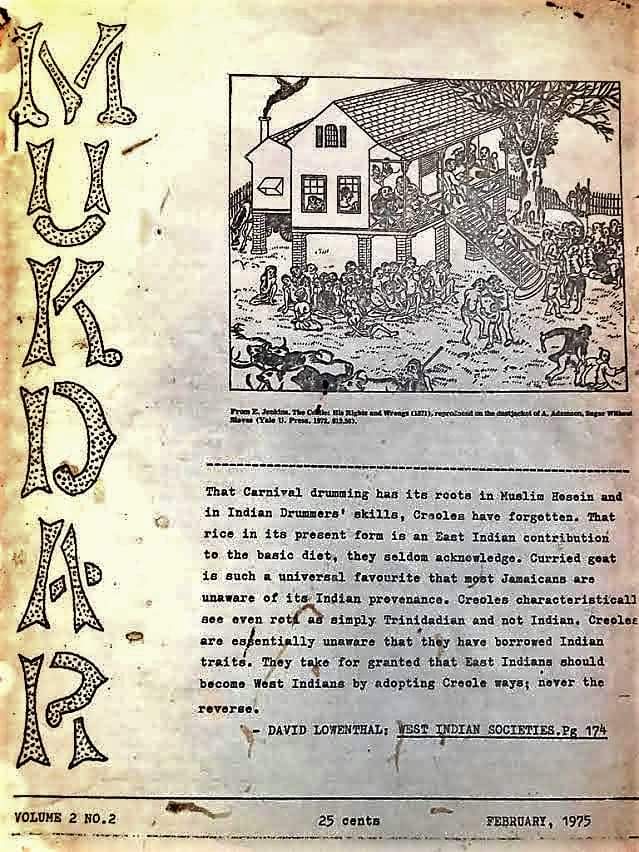Day 18 of 31 — a Month of Reflections and Tributes to Indians in Trinidad
RAMDATH JAGESSAR – PIONEER FOR INDIAN ARRIVAL DAY in TRINIDAD
Indian Arrival Day is a national public holiday, but how many of you know how it came to be?
Well, I had planned to interview the man Ramdath Jagessar described by his peers as The Pioneer for Indian Arrival Day, but my message on April 20, went unanswered. It was unlike him. I decided to send him a reminder, and that’s when I saw the response from his wife Jiantee that he had passed – hours after my message was sent. She said: “His soul must have visited you, so you thought of him”. (that’s another topic).

In her eulogy, she recalled how he tore his father’s Will after his father’s death because “he had left all of 84 acres of land to the two oldest boys and nothing for the girls”. That’s the type of man “Ram” was, she said.
Born in 1947, the second son to Lall and Lillian Jagessar’s eight children, he and Jiantee were married in 1974. They have two sons Arvind and Rishi.
She described him as a lifelong educator and counsellor. “Ram was fearless; he was never afraid to challenge systemic racism in a corrupt government that governed along racial lines.”
It was no wonder that Jagessar, formed the ‘grassroot group of 7’ (as he called it) that initiated the call for the recognition of the arrival of Indians in this country. Other members of that historic Committee were Anand Rameshwar Singh, Khalique Khan, Rajiv Sieunarine, Azamudeen “Danny” Jang, Michael Sankar, and Rajesh Harricharan. The following year Rajnie Ramlakhan, Anand Maharaj and Ashok Gobin joined the group.
Jiantee said Jagessar had “embarked on a flurry of activities and writings just before he died, as if he were cramming for his death. He wrote his own resume … and was writing about the Pioneers of Indian Arrival Day and related festivals in the Caribbean”. He did not complete it, but it is well known.
In his last writings, Jagessar noted that after The Indian Centenary celebrations in 1945 which was spearheaded by Murli Kirpalani, there was a lull until 1972, when the Divine Life Society started celebrating Indian Emigration Day in Trinidad by holding annual processions. (Incidentally, our DLS group from Quarry Village was part of those processions).
Then in 1977-1978 a spin-off the Indian Emigration Day came the formation of the seven-member group – Indian Revival and Reform Association (IRRA) with the aim to revive Indian Culture and heritage. “Only Rajiv Sieunarine was thinking of Emigration Day,” Jagessar wrote.
Jagessar said, it was the late artist/activist Danny Jang who pronounced: “We are not immigrants; we were born here. We have arrived,” which led to the name change to Indian Arrival.
By 1979, the IRRA formed an Indian Arrival Day Committee that began hosting functions to raise awareness and to honour the Indian ancestors. They met with various organizations including the Sanatan Dharma Maha Sabha (SDMS). This resulted in the first huge “Indian Arrival Day” celebrations at the Lakshmi Girl’s Hindu College, hosted by the late Sat Maharaj, secretary general of the SDMS.
The celebrations gained momentum and continued annually across the country. Formation of several other groups saw the revival of enthusiasm for Indian culture and awareness which increased to about ten annual celebrations across the country by 1985. There was a widespread call for recognition of Indian Arrival Day as a public holiday.
In 1991, MP Trevor Sudama, supported the cause by piloting the bill in Parliament for the holiday. He, together with MP Raymond Pallackdharrysingh championed the call, the debate, and the arguments in Parliament.
In 1995 for the 150th anniversary of arrival of the first set of Indians on the Fatel Rozark, Prime Minister Patrick Manning announced May 30 as Indian Arrival Day – for that year only. He said thereafter it would be known as Arrival Day.
In 1996 however, then Prime Minister Basdeo Panday renamed it Indian Arrival Day.
Further to that, the SDMS began observing the month of May as Indian Heritage Month, ending on May 30, with Indian Arrival Day celebrations.
Jagessar was much more than a pioneer of Indian Arrival Day. He was a teacher, journalist, social and cultural activist and an unrelenting champion of “Indian” rights.
In the 1970’s, Jagessar, Lloyd Haridan and others started “Mukdar”, a journal that focused on the interest and welfare of those in the sugar industry. They highlighted the discrimination against Indians in areas such as employment in the public service, culture etc and even neglect of the rural areas.
Even in Canada, Sadbury where he migrated, he continued to be a voice for the visible minorities for many years.
Jagessar was praised by his peers as the man with the ‘foresight and pioneering work’ that led to Indian Arrival Day being recognized not only in this country, but in Guyana, Grenada, Fiji, Suriname, South Africa, Mauritius, and several other Caribbean islands.
Jiantee said Jagessar: “did not stop at anything – the sky was his limit in his search for the truth…”
~~~~~ reflecting on Arrival & Survival of our ancestors -178th anniversary of arrival. (Indian Heritage Month)
